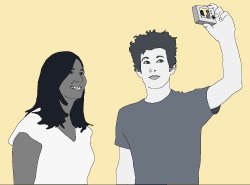Step-by-step guide on how to shoot video podcasts
 Site Make Internet TV - this is step-by-step instructions for shooting, editing and publishing online videos, that is, video podcasts. Your viewers can subscribe and automatically download the video as soon as you make it.
Site Make Internet TV - this is step-by-step instructions for shooting, editing and publishing online videos, that is, video podcasts. Your viewers can subscribe and automatically download the video as soon as you make it.In his recent podcast, the well-known umputun expressed regret that he did not have enough knowledge to start recording his video podcast. This site was created specifically for him and for people like him.
1. Equipment .
For shooting video you can use either a DV-camcorder or a digital camera, the benefit of which the latter have now learned to shoot perfectly with a resolution of 640 × 480 at 30 frames / s, which is quite enough for the Internet. Both have advantages and disadvantages. The camera is smaller and cheaper. The video camera provides better quality, gives more settings and records on the tape.
Be sure to need a tripod.
')
 It is necessary to purchase headphones and microphones , including a handheld microphone, a buttonhole microphone with a long cable and a narrowly targeted "long-range" microphone.
It is necessary to purchase headphones and microphones , including a handheld microphone, a buttonhole microphone with a long cable and a narrowly targeted "long-range" microphone.A separate story - the purchase of lighting fixtures : reflectors, working lamps on racks, as well as inexpensive lamp-lanterns, which can be attached to something. Optional accessories are Chinese lanterns for soft light, pieces of cloth for diffusing light. However, they can be made from the old tights of his wife, as well as many other accessories you can make yourself.
The last but not the least important accessory that you will need to shoot a video is a computer . You will have to break your head a lot to choose a platform: Mac or PC.
 2. Shooting .
2. Shooting .Pictures clearly show how to hold the camera if you shoot with one hand, two hands, above your head, in front of you when shooting in the style of video blog,
From this part of the tutorial, you will learn that you need to shoot as much as possible, even if you think you shot enough, keep shooting. Additional material never hurts during installation.
It is best to shoot not with your hand, but with a tripod: this will save you 98% of the problems, and the picture will be much more professional. Avoid using zoom and frequent changes of plans, as well as special effects built into the camera. It is better to add them during installation.
Special skills are required to provide high-quality sound when shooting video. To do this, you need to isolate the sound source well and constantly monitor the sound in the headphones.
Separate sections of the textbook are devoted to tips on lighting , frame building and composition , plot planning .
3. Installation .
The choice of software depends entirely on which platform you choose to install. Here are tips for Windows , Mac and GNU / Linux .
4. License .
When the video file is ready for publication, the final touch remains: the choice of license. Here the alternative is simple: either copyright ( more ), or copyleft, that is, Creative Commons ( advice ).
 5. Publication .
5. Publication .There are two options for posting your videos on the Internet: either using video services , many of which even pay for the number of views, or as a video blog .
6. Promotion .
How to promote your RSS feed and create a community of viewers participating in your video show - tips here .
Source: https://habr.com/ru/post/7933/
All Articles